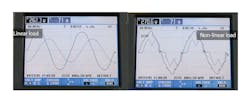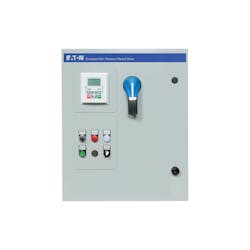Q: First, when and why would an operator choose a variable frequency drive?
A: Variable frequency drives (VFDs) are an advanced type of motor starter, and they are employed when systems require more than your basic on/off motor capability. This can include speeding a motor up, slowing it down, and reversing its direction. They also provide an operator interface and programmable functionality to a system, and they can be equipped with additional protective and communication features. Some common VFD applications include HVAC fans, water pumps and commercial conveyors.
Aside from the added capabilities that a drive adds to a system, VFDs can result in lower energy and capital costs. The ability to regulate the speed of your motor allows for reduced energy consumption since the motor does not have to be constantly run at full throttle. This also reduces the mechanical stress and associated repairs on your system, as the motor can be revved up or down gradually, rather than exposing high starting torques to system components such as shafts, belting and gears.
Q: So, how are harmonics involved?
A: As VFDs become increasingly more popular, harmonics become more of a focal subject. Drives are inherently AC-to-DC conversion devices. They adjust motor speeds by receiving an incoming AC current and converting it to a more manipulatable DC current. The DC frequency and respective motor speed is then altered accordingly, and finally, the drive converts the DC current back to AC in the form of a sine wave. This conversion process creates harmonic distortion as shown in Figure 2. Drives are not the only devices generating harmonic distortion, however. Nonlinear loads such as UPSs, computer chargers and LED lights similarly convert AC to DC.
Q: Why should I care about harmonics?
A: Harmonic distortion can be destructive to an operation’s equipment and budget. The presence of too much harmonic distortion in an electrical system can result in overheating and efficiency loss of transformers, reduced generator capacity, nuisance tripping of connected devices and diagnostic equipment, and disrupted communications between sensitive electronics. This in turn can lead to premature failure or reduced life span of equipment, resulting in downtime, loss of productivity and capital expense.
Utilities have also started issuing fines for the addition of “unclean power” to the grid per the guidelines outlined in IEEE 519-2014. IEEE dictates that the utility is responsible for providing clean power to its customers, and similarly, customers are responsible for not injecting excessive harmonics into the power grid. Harmonics are essentially power that is not doing useful work, so IEEE 519-2014 defines a recommended harmonic limit at the point of common coupling or the point where the utility connects to multiple customers.
Q: How is harmonic distortion measured?
A: Total harmonic distortion (THD) can be thought of as a sine wave quality factor. It is a percentage representing how close a distorted waveform is to a true sine wave. THD is the percentage of distortion, so the greater its value, the further the waveform is from a true sine wave and vice versa. Total harmonic distortion can then be compared to the full load of the system to evaluate total demand distortion (TDD). With this relationship, similar THD levels become less of an issue on greater loads, and systems with a lower percentage of nonlinear loads are not as affected by THD.
Q: How do I prevent harmonic distortion?
A: Several VFD offerings are available on the market offering clean power solutions in accordance with the previously mentioned IEEE 519-2014 standard. These drives incorporate various techniques including line reactors, passive filters, pulse rectifiers and active front ends to mitigate undesirable harmonics. With the variety of options available, the challenge can be choosing the appropriate one for your specific application.
Q: What about active front-end solutions?
A: Both previously mentioned technologies are considered passive systems, whereas an active solution incorporates a switching device. Active front-end (AFE) solutions do this with insulated-gate bipolar transistors (IGBTs), also complying with IEEE 519-2014 and bringing harmonic levels into the 3% to 5% TDD range. Both passive and active solutions deliver similar efficiency and footprint; however, the addition of active switching devices adds complexity, cost and additional maintenance to the drive when compared to passive solutions. The aforementioned 18-pulse EGP drive offers easy installation and startup and requires minimal maintenance. AFE drives, on the other hand, have more parameters to configure and require more tuning; they can also be more susceptible to power quality disturbances compared to their passive alternatives. An active front-end drive can be an effective harmonic solution in a variety of applications, but it is not always the most cost-effective option available.
Q: So, how do I choose the appropriate mitigation solution?
A: The key to choosing the ideal harmonic mitigation solution is understanding the application. Several clean power options are robust, but their price tag will likely reflect that. Some of the more advanced offerings will require a larger overall footprint as well. With that in mind, it is important to balance cost and size limitations when determining the best solution. It is also important to know the harmonic requirements of the system to avoid overdesigning and in turn, overspending.
When comparing two of Eaton's offerings, the passive filter or 18-pulse design both may meet the harmonic needs of a given system, but the specific application may align better with one over the other. Commercial applications, as an example, may be more cost- and size-conscious, and the system’s power quality may be relatively better due to a smaller presence of drives and generators. This application would lend itself better to a passive filter solution, especially at lower horsepower loads.
An industrial application, on the other hand, may be more concerned with minimal maintenance and resilience to power disturbances and standby generation interference. In this case, the 18-pulse design would be more effective, especially at higher horsepower loads.
With a strong understanding of application and system requirements with regard to harmonics, the ideal harmonic mitigation technique can be more easily determined. It does not have to fall entirely in your hands though. Eaton's application engineers can help deliver a cost-effective solution aligned with IEEE 519-2014 recommendations. The big takeaway is that you do not have to spend more than you need. The variety of options exist to ensure that an ideal solution can be designed to meet both your harmonic and budgetary needs.
Paul Olis is a marketing analyst for Eaton’s enclosed variable frequency drives product line. He has a Bachelor of Science in mechanical engineering from Purdue University Northwest. He is in his third and final year of Eaton’s rotational leadership program, having already completed roles as a quality engineer for medium voltage drives and as a division sales engineer for low voltage switchgear.





